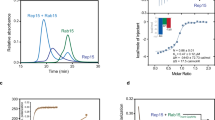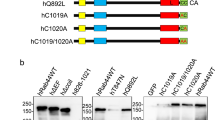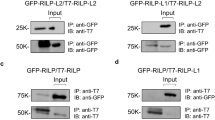Abstract
Rab GTPases regulate all stages of membrane trafficking, including vesicle budding, cargo sorting, transport, tethering and fusion1,2. In the inactive (GDP-bound) conformation, accessory factors facilitate the targeting of Rab GTPases to intracellular compartments3,4,5,6,7,8. After nucleotide exchange to the active (GTP-bound) conformation, Rab GTPases interact with functionally diverse effectors including lipid kinases, motor proteins and tethering complexes. How effectors distinguish between homologous Rab GTPases represents an unresolved problem with respect to the specificity of vesicular trafficking. Using a structural proteomic approach, we have determined the specificity and structural basis underlying the interaction of the multivalent effector rabenosyn-5 with the Rab family. The results demonstrate that even the structurally similar effector domains in rabenosyn-5 can achieve highly selective recognition of distinct subsets of Rab GTPases exclusively through interactions with the switch and interswitch regions. The observed specificity is determined at a family-wide level by structural diversity in the active conformation, which governs the spatial disposition of critical conserved recognition determinants, and by a small number of both positive and negative sequence determinants that allow further discrimination between Rab GTPases with similar switch conformations.
This is a preview of subscription content, access via your institution
Access options
Subscribe to this journal
Receive 51 print issues and online access
$199.00 per year
only $3.90 per issue
Buy this article
- Purchase on Springer Link
- Instant access to full article PDF
Prices may be subject to local taxes which are calculated during checkout




Similar content being viewed by others
References
Pfeffer, S. R. Rab GTPases: specifying and deciphering organelle identity and function. Trends Cell Biol. 11, 487–491 (2001)
Zerial, M. & McBride, H. Rab proteins as membrane organizers. Nature Rev. Mol. Cell Biol. 2, 107–117 (2001)
Sivars, U., Aivazian, D. & Pfeffer, S. R. Yip3 catalyses the dissociation of endosomal Rab-GDI complexes. Nature 425, 856–859 (2003)
Rak, A. et al. Structure of Rab GDP-dissociation inhibitor in complex with prenylated YPT1 GTPase. Science 302, 646–650 (2003)
Calero, M. et al. Dual prenylation is required for Rab protein localization and function. Mol. Biol. Cell 14, 1852–1867 (2003)
Rak, A. et al. Structure of the Rab7:REP-1 complex: insights into the mechanism of Rab prenylation and choroideremia disease. Cell 117, 749–760 (2004)
Seabra, M. C. & Wasmeier, C. Controlling the location and activation of Rab GTPases. Curr. Opin. Cell Biol. 16, 451–457 (2004)
Pfeffer, S. & Aivazian, D. Targeting Rab GTPases to distinct membrane compartments. Nature Rev. Mol. Cell Biol. 5, 886–896 (2004)
Chavrier, P., Parton, R. G., Hauri, H. P., Simons, K. & Zerial, M. Localization of low molecular weight GTP binding proteins to exocytic and endocytic compartments. Cell 62, 317–329 (1990)
Feng, Y., Press, B. & Wandinger-Ness, A. Rab 7: an important regulator of late endocytic membrane traffic. J. Cell Biol. 131, 1435–1452 (1995)
Lombardi, D. et al. Rab9 functions in transport between late endosomes and the trans Golgi network. EMBO J. 12, 677–682 (1993)
Mesa, R., Salomon, C., Roggero, M., Stahl, P. D. & Mayorga, L. S. Rab22a affects the morphology and function of the endocytic pathway. J. Cell Sci. 114, 4041–4049 (2001)
Kauppi, M. et al. The small GTPase Rab22 interacts with EEA1 and controls endosomal membrane trafficking. J. Cell Sci. 115, 899–911 (2002)
Junutula, J. R. et al. Rab14 is involved in membrane trafficking between the Golgi complex and endosomes. Mol. Biol. Cell 15, 2218–2229 (2004)
Simpson, J. C. et al. A role for the small GTPase Rab21 in the early endocytic pathway. J. Cell Sci. 117, 6297–6311 (2004)
Vitale, G. et al. Distinct Rab-binding domains mediate the interaction of Rabaptin-5 with GTP-bound Rab4 and Rab5. EMBO J. 17, 1941–1951 (1998)
de Renzis, S., Sonnichsen, B. & Zerial, M. Divalent Rab effectors regulate the sub-compartmental organization and sorting of early endosomes. Nature Cell Biol. 4, 124–133 (2002)
Fouraux, M. A. et al. Rabip4' is an effector of rab5 and rab4 and regulates transport through early endosomes. Mol. Biol. Cell 15, 611–624 (2004)
Fukuda, M. Distinct Rab binding specificity of Rim1, Rim2, rabphilin, and Noc2. Identification of a critical determinant of Rab3A/Rab27A recognition by Rim2. J. Biol. Chem. 278, 15373–15380 (2003)
Pfeffer, S. R. Structural clues to Rab GTPase functional diversity. J. Biol. Chem. 280, 15485–15488 (2005)
Ostermeier, C. & Brunger, A. T. Structural basis of Rab effector specificity: crystal structure of the small G protein Rab3A complexed with the effector domain of rabphilin-3A. Cell 96, 363–374 (1999)
Zhu, G. et al. Structural basis of Rab5-Rabaptin5 interaction in endocytosis. Nature Struct. Mol. Biol. 11, 975–983 (2004)
Pereira-Leal, J. B. & Seabra, M. C. The mammalian Rab family of small GTPases: definition of family and subfamily sequence motifs suggests a mechanism for functional specificity in the Ras superfamily. J. Mol. Biol. 301, 1077–1087 (2000)
Pereira-Leal, J. B. & Seabra, M. C. Evolution of the Rab family of small GTP-binding proteins. J. Mol. Biol. 313, 889–901 (2001)
Merithew, E. et al. Structural plasticity of an invariant hydrophobic triad in the switch regions of Rab GTPases is a determinant of effector recognition. J. Biol. Chem. 276, 13982–13988 (2001)
Heo, W. D. & Meyer, T. Switch-of-function mutants based on morphology classification of Ras superfamily small GTPases. Cell 113, 315–328 (2003)
Chen, D., Guo, J., Miki, T., Tachibana, M. & Gahl, W. A. Molecular cloning of two novel rab genes from human melanocytes. Gene 174, 129–134 (1996)
Rodriguez-Gabin, A. G., Cammer, M., Almazan, G., Charron, M. & Larocca, J. N. Role of rRAB22b, an oligodendrocyte protein, in regulation of transport of vesicles from trans Golgi to endocytic compartments. J. Neurosci. Res. 66, 1149–1160 (2001)
Vetter, I. R. & Wittinghofer, A. The guanine nucleotide-binding switch in three dimensions. Science 294, 1299–1304 (2001)
Panic, B., Perisic, O., Veprintsev, D. B., Williams, R. L. & Munro, S. Structural basis for Arl1-dependent targeting of homodimeric GRIP domains to the Golgi apparatus. Mol. Cell 12, 863–874 (2003)
Acknowledgements
We are grateful to M. Zerial for a full-length clone of rabenosyn-5; E. Kittler and M. Zapp for assistance with surface plasmon resonance experiments; and A. Delprato for Rab5 mutants. Surface plasmon resonance data were collected in the UMASS Center for AIDS Research Molecular Biology Core. This work was supported by an NIH grant.
Author information
Authors and Affiliations
Corresponding author
Ethics declarations
Competing interests
Coordinates and structure factors have been deposited in the Protein Data Bank under the codes 1YZM (Rbsn(458–503)), 1Z0J (Rab22–Rbsn(728–784)), 1Z0K (Rab4–Rbsn(440–503)) and as listed in Supplementary Table 3 (Rab GTPases). Reprints and permissions information is available at npg.nature.com/reprintsandpermissions. The authors declare no competing financial interests.
Supplementary information
Supplementary Figure S1
Electron density for functionally relevant regions (PDF 589 kb)
Supplementary Figure S2
Influence of crystal packing on the active and inactive structures of Rab GTPases (PDF 498 kb)
Supplementary Figure S3
Survey of structural similarity, variability and plasticity in the Rab family (PDF 502 kb)
Supplementary Figure S4
Mapping and structure of the Rabenosyn-5 Rab binding domains (PDF 426 kb)
Supplementary Figure S5
Quantitative family-wide analysis of Rab-effector specificity. (PDF 240 kb)
Supplementary Figure S6
Schematic diagram of intermolecular interactions in the Rab-Rabenosyn-5 complexes. (PDF 319 kb)
Supplementary Figure S7
Reversal of specificity mutations in the Rabenosyn-5 Rab binding domains. (PDF 324 kb)
Supplementary Table S1
Rab constructs and constructs used for crystallization. (PDF 42 kb)
Supplementary Table S2
Crystallization, data collection and refinement statistics. (PDF 84 kb)
Supplementary Table S3
Summary of Rab GTPase structures analyzed with references to original work (PDF 51 kb)
Rights and permissions
About this article
Cite this article
Eathiraj, S., Pan, X., Ritacco, C. et al. Structural basis of family-wide Rab GTPase recognition by rabenosyn-5. Nature 436, 415–419 (2005). https://doi.org/10.1038/nature03798
Received:
Accepted:
Issue Date:
DOI: https://doi.org/10.1038/nature03798
This article is cited by
-
Enhanced mapping of small-molecule binding sites in cells
Nature Chemical Biology (2024)
-
Rab GTPases and phosphoinositides fine-tune SNAREs dependent targeting specificity of intracellular vesicle traffic
Nature Communications (2024)
-
EnCPdock: a web-interface for direct conjoint comparative analyses of complementarity and binding energetics in inter-protein associations
Journal of Molecular Modeling (2023)
-
Fine-tuning cell organelle dynamics during mitosis by small GTPases
Frontiers of Medicine (2022)
-
Conventional Molecular and Novel Structural Mechanistic Insights into Orderly Organelle Interactions
Chemical Research in Chinese Universities (2021)
Comments
By submitting a comment you agree to abide by our Terms and Community Guidelines. If you find something abusive or that does not comply with our terms or guidelines please flag it as inappropriate.



